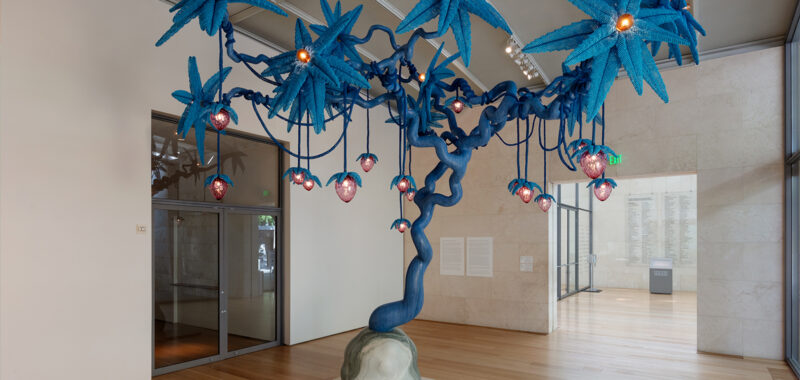DALLAS — During my three-day visit to Dallas, my hotel hosted a conference on Conscious Capitalism. Each morning, I sat in the lobby and eavesdropped on attendees’ experiences with, per the conference’s website, the intersection of business and humanity. This is one junction of many that have risen to popularity in recent years. I imagine that just down the street from Conscious Capitalism, for example, one might find the intersection of art and design, or even the bustling intersection of art and technology. After breakfast, I walked a few blocks to the Nasher Sculpture Center, where the Haas Brothers made my metaphor literal. Known for their collaborations with Donatella Versace and luxury homeware brand L’Objet, the twin brothers’ current museum exhibition, Haas Brothers: Moonlight, demonstrates the design duo’s increasing interest in visual art, negotiating a salable, utopian space between form and function.

The sculptures on view propose alternatives to conventional design. Soft, rounded edges and dense natural materials evoke ecological structures while maintaining practical purposes. Outside the museum, two adjacent blue street lamps, both entitled “Let There Be Street Light” (2023), resemble cartoon tree trunks topped with drooping orbs that emit muted, white light. The two sculptures reference the Moonlight Towers of the brothers’ youth in Austin, Texas, which bathed whole neighborhoods in simulated moonlight. In contrast, the Nasher’s lamps cast a limited glow, closer to that of a typical streetlight. Mingling natural forms with common public infrastructure, the Haas Brothers’ works are, perhaps ironically, less accessible than their referents: “Donut Eater” (2019), in the museum’s sequestered garden, is a stone bench that can accommodate just a few occupants, all facing away from each other due to the sculpture’s circular construction. The work is like much expensive furniture: not very comfortable to sit on, but pleasing to look at.

In the Haas Brothers’ tech-infused, futuristic sculpture, nature is decorative, fun, and fertile — and not under threat. Their newest work utilizes software coded to initial specifications, and then allowed to run autonomously until the emergent form resembles a desired shape. This process generates objects that recall existing natural growths while deviating from them. Strawberries, for example, grow on small plants, but in “The Strawberry Tree” (2024), the brothers envision the berries in an exaggerated, fictitious light: Beaded vines drape across a large blue tree hung with illuminated glass bulbs that are shaped like oversized, airbrushed strawberries. This transformation turns a mass agricultural product — one already heavily influenced by human intervention — into an example of lush, permanent wilderness. This flourishing natural world, though, serves a decadent, rarified purpose: The sculpture conveniently doubles as an ornate chandelier.
The Haas Brothers’ sculpture can appear simultaneously optimistic and blasé about the future. Their witty, ecological re-creations proffer an environment that is knowingly — and laughably — unrealistic, inflecting their functional sculpture with a winking irony. The resulting exhibition feels like a new breed of kitsch: These fantastical, pricey homages to our dying landscape traffic in the same profitable system that quickened its demise. In this way, the Haas Brothers leverage a cynical truism. Access to natural beauty (or even just clean air and water) is increasingly an indicator of wealth and privilege — just like owning one of these sculptures.

Haas Brothers: Moonlight continues at the Nasher Sculpture Center (2001 Flora Street, Dallas, Texas) through August 25. The exhibition was curated by Brooke Hodge.

